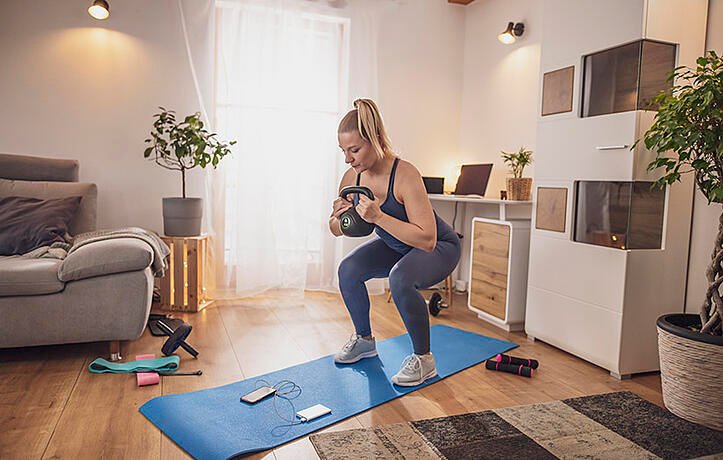By KINSEY MAHAFFEY
Squats are a staple exercise in any workout. From bodyweight squats to barbell squats and everything in-between, you can find a squat variation that uses almost any equipment type. Not only is the squat one of the most functional exercises, but it’s also increasingly popular among gym-goers who are looking to build stronger glutes.
When it comes to building the glutes effectively, range of motion matters. The limiting factor in achieving an ideal range of motion in a squat is often the exerciser’s ability to get to the proper squat depth while also maintaining good form.
If you’re looking for a squat variation that allows you to get lower without sacrificing your form, look no further than the goblet squat.
HOW TO PERFORM A GOBLET SQUAT IN 3 STEPS
1. Starting position: Stand with your feet hip or shoulder-width apart, toes pointed straight ahead. Tighten your abs and hold the kettlebell at chest height by holding the sides of the handle. Pull the kettlebell close to your body and squeeze your shoulder blades together.
2. Sit your hips back and bend your knees to lower yourself into a squat. Keep the chest up as you squat and squat as low as you can while keeping your back straight (when your back starts to round, that’s too low).
3. Drive through the feet as you stand and squeeze your glutes as you return to a tall standing position.
GOBLET SQUAT MODIFICATIONS
The goblet squat got its name from the fact that it looks like you’re holding a goblet.
If you don’t have a kettlebell, you can use a dumbbell, a medicine ball, or any piece of equipment that allows you to grasp it with both hands at chest height. Dan John, the movement’s creator, has even been known to recommend a rock or stone to perform the exercise!
When using a dumbbell, hold it vertically and place your palms underneath the top of the weight. Don’t grip the weight too tightly. You can also use a medicine ball by holding it between two hands at chest height. You might find it more comfortable to place the hands slightly underneath the medicine ball to help you hold it up if it is a larger medicine ball.
HOW TO DO GOBLET SQUATS WITH PERFECT FORM
Any exercise worth doing is worth doing right, and the goblet squat is no exception. Alignment matters in any movement because it will directly impact which muscle groups are working and at what time.
Proper alignment will ensure that you’re firing the right muscles at the right time so that you can get the results that you want. Working from the ground up, here are some key checkpoints to be mindful of when doing goblet squats:
Feet: Keep your feet pointed straight ahead like you’re standing on skis. One common mistake to look out for is turning the feet out during the squat, so be sure that your feet stay straight ahead during the movement.
Knees: Your knees should stay in line with your shoelaces during the squat. One common mistake is to let the knees cave in at some point during the squat motion. If you find that this is happening to you, you might place a loop resistance band around your thighs, just above your knees, and focus on keeping pressure on the band during the movement. You’ll feel your glutes working a little bit harder when you add the band, too!
Lumbo-pelvic hip complex (LPHC): The LPHC includes the hips and low back. During any squat motion, you want your spine to stay straight the entire time. If your hips tuck under at the bottom of the squat (known as a “butt wink”), you might be squatting too low. Squat as low as you can without losing neutral spine.
LEANING FORWARD DURING SQUAT
You shouldn’t lean too far forward during the squat. From a side view, your back and your shins should be parallel. Luckily, holding the weight in front of your body should help you to stay more upright. Focusing on keeping the chest tall and shoulders pulled back should help you maintain proper position the whole time.
Shoulders: Keep your shoulders pulled back and down. My favorite cue for this is to keep the shoulder blades tucked into the back pocket. This will keep you from allowing the weight to pull your shoulders forward and out of position. Keeping your shoulder blades squeezed together will also keep the weight close to your body. If the weight drifts out in front of you, it might cause strain in the lower back.
Head: From a side view, your ears should be in line with your shoulders. From the starting position, keep your chin tucked and make sure you have your ‘head on your shoulders before you squat. You know your head is out of alignment when your chin is jutting out forward, or you look up excessively during the squat.
WHAT MUSCLES DO GOBLET SQUATS WORK?
Similar to other squatting movements, goblet squats mainly work the quads and glutes. Because you are holding the weight at chest height, the core will stabilize the trunk during the movement, while the lats and upper back muscles work to keep the kettlebell or dumbbell in place.
4 BENEFITS OF GOBLET SQUATS
The benefits of the goblet squats are:
- Increased range of motion & More Glute Activation
- Increased core activation
- Reduced risk of injury
- Flexible equipment options
INCREASED RANGE OF MOTION = MORE GLUTE ACTIVATION
Holding the weight at the chest allows many to squat to lower depths by shifting their center of gravity. Having the kettlebell or dumbbell in front of the body and at chest height causes you to shift your weight back onto the heels a little bit more.
The weight can also slightly offset your weight during the squat, making it easier to balance as you sink lower into the squat. The lower you can squat with good form, the more the glutes are stretched, producing greater strength in the glutes.
#2 INCREASED CORE ACTIVATION
Whenever the weight is above the waist during a squat, the core must work harder to keep the spine neutral and in the correct position during the movement. In goblet squats, the weight placement will train the core muscles to maintain good form in the LPHC during a squat.
#3 REDUCED RISK OF INJURY
One concern that many exercisers have when doing squats is protecting the back from injury. The good news is that having to hold the weight at chest-height during goblet squats self-limits the load. This can reduce your risk of injury since you can’t lift what you can’t hold.
#4 FLEXIBLE EQUIPMENT OPTIONS:
Just because you don’t have access to a kettlebell doesn’t mean you can’t perform this move. You can use a dumbbell, medicine ball, or any item that you can hold and control with good form.
CONCLUSION AND CONTEXT
Whether you’re looking to improve your overall squat pattern, get lower in your squats, build your glutes, or you want to try a different squat variation, the goblet squat is a great movement to incorporate into your next workout.
The goblet squat was created by a strength and conditioning coach named Dan John. He created the movement to help new exercisers learn how to squat with good form.
While this variation is known for assisting exercisers to improve their overall squat pattern, it’s also known for building glute strength due to the squat’s lower depth. Whether you’re just starting at the gym or you’ve been exercising for a while, the goblet squat is a great squat variation to include in your workout routine to build glute strength.
THE AUTHOR

KINSEY MAHAFFEY
Kinsey Mahaffey, MPH, is a Houston-based fitness educator, personal trainer and health coach who developed her commitment to lifelong fitness while playing Division I volleyball. She’s passionate about helping others cultivate a healthy lifestyle and enjoys educating other fitness professionals who share this vision. She’s a Master Instructor and Master Trainer for NASM.

